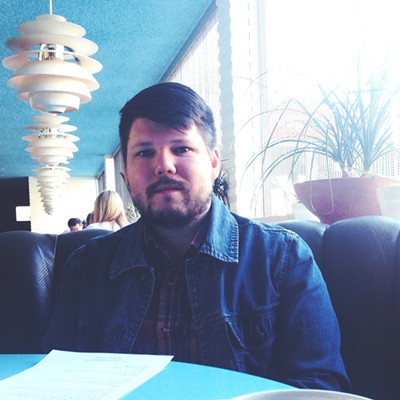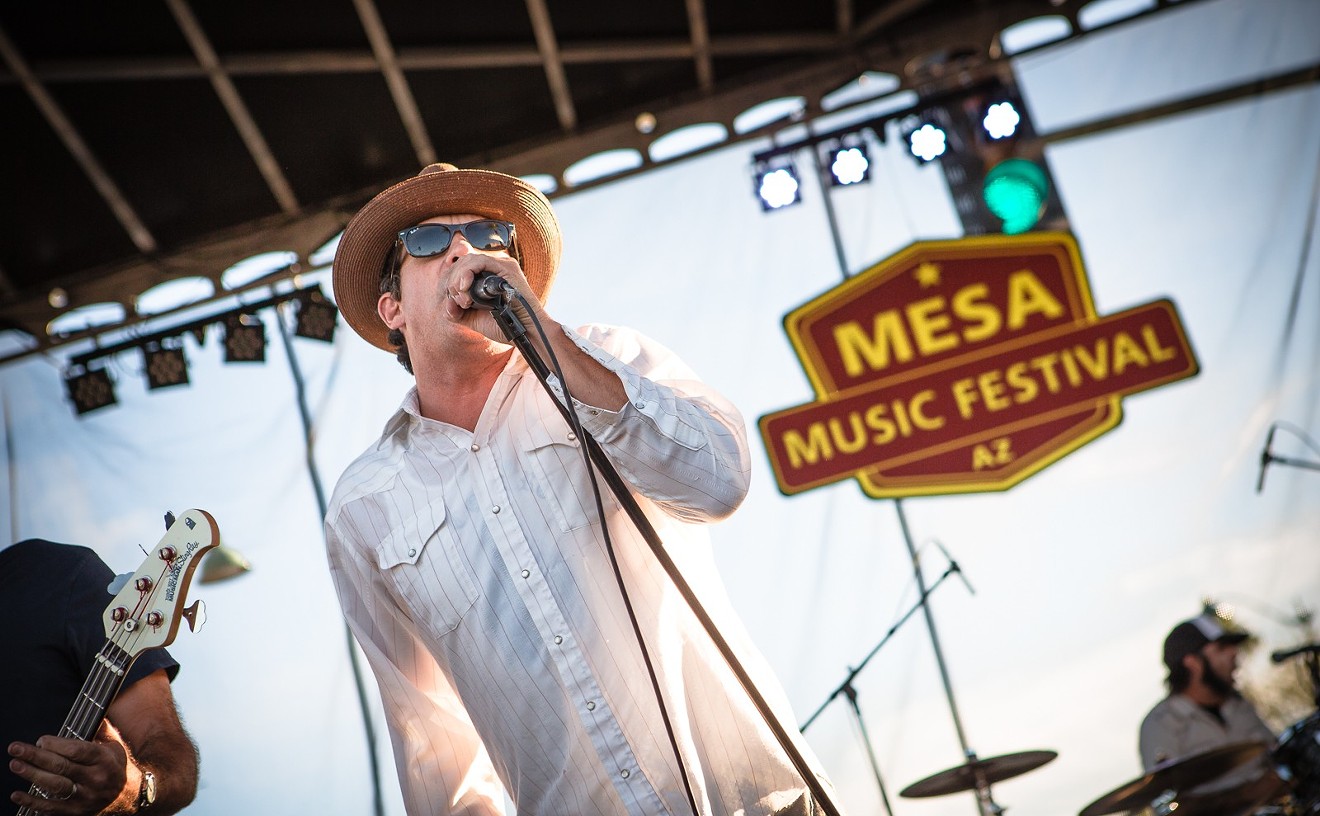In 1956, a twangy rockabilly song called "The Fool" announced to the country that Phoenix, Arizona, was good for more than temperate winters and citrus groves.
Sung by Sanford Clark, a baby-faced kid stationed at Luke Air Force Base, the song was written and produced by local DJ Lee Hazlewood and blessed with the thwacking leads of guitarist Al Casey. It was recorded at Floyd Ramsey's Audio Recorders studio on Seventh Street and Weldon Avenue and released on a small Phoenix label, MCI Records. From there it bloomed, picked up by Dot Records and distributed nationally. By the end of 1957, "The Fool" had sold more than 800,000 copies and set the blueprint for the "Phoenix sound," an echoing, reverb-drenched take on rockabilly that would propel guitarist Duane Eddy to fame, inspire Phil Spector's Wall of Sound, and lay the groundwork for the outlaw country stardom of Waylon Jennings.
Fittingly, the recording of "The Fool" appears near the beginning of author Jim West's The Phoenix Sound: A History of Twang & Rockabilly Music in Arizona. A longtime radio man in Phoenix, he got his start on the air while serving in the Air Force, stationed in South Dakota "at a little podunk little country AM station in the '70s," West says, sipping iced tea at Casey Moore's Oyster House on a brisk November evening.
See also: 10 Songs That Define The Phoenix Sound
A native Tucsonan, he returned there in 1976 and began picking up work at stations. Eventually, he received a job offer from Buck Owen's Phoenix radio station, KNIX. Though he dug jazz, "underground AOR," and oldies — "anything from Sinatra to Hank Williams" — he particularly excelled with the station's country format. From there, he spent time in Indianapolis, eventually returning to Phoenix to work at KMLE in 1988. Work brought him to stations in Georgia, New Mexico, Maryland, and Colorado before returning to Arizona.
"I always wanted to make a difference as far as informing the public on the kind of music they liked to hear," West says.
When he returned to Phoenix and began working with the Arizona Music and Entertainment Hall of Fame, he got the idea to write a book overviewing the explosion of rockabilly and western music in Phoenix in the 1950s. The writing process took him five years, during which he interviewed many of the key players, including engineer Jack Miller of Audio Recorders and Canyon Records, Duane Eddy, pianist-turned-preacher Jimmy Dell, promoter Ray Odom (the "Dick Clark of country music," West writes), and more.
West says The Phoenix Sound isn't the definitive statement on the subject — a new Bear Family Records compilation, The MCI Records Story: 1954-61, serves as a perfect companion, filling in some sonic gaps — but the book serves as an introduction to the sounds and characters that helped create it, from stars like Eddy, Jennings, and Hazlewood to less-lauded but important players like Casey, his then-wife and ace session guitarist Corki Casey O'Dell, crooner Connie Conway, and dozens more. "The influence of all these collective people . . . [made its way to] people like the Beatles and more down the road," West says.
The Phoenix Sound: A History of Twang & Rockabilly Music in Arizona is scheduled for release on Monday, December 7.
tweet this
In the 1950s, Phoenix was a rapidly growing city, and as it grew, its unique sound solidified. "In the '50s, you had the Memphis sound, with Elvis, Jerry Lee Lewis, and Johnny Cash, and the Motown sound in Detroit," West says, also noting the sharp Bakersfield sound and the West Coast studio sound in L.A. "Phoenix had its own little sound, too, which is not as well known," West says.
The roots of that sound stretch further south, to a small cotton town called Coolidge, Arizona. Following his discharge from the military, Hazlewood worked at a small station there, KCKY, where he met a Coolidge high schooler named Duane Eddy, who provided on-air performances on his guitar. Not long after Hazlewood headed to Phoenix, Waylon Jennings settled in at KCKY following the death of his former bandmate Buddy Holly. The small station served as an incubator, but it was in Phoenix that Hazlewood, Eddy, and Jennings found solid artistic footing. Ramsey's Audio Recorders studio offered the best gear, and Hazlewood took to the equipment and developed a reputation as a fierce taskmaster in the studio. When "The Fool" took off, the search for another hit was on.
Eddy proved the right guy for the job. His twangy guitar, booming and low like Arizona's canyons, was the result of Hazlewood's ear and Eddy's willingness to experiment. Along with Miller and Ramsey, the duo rigged up an echo tank from an above-ground silo. The utterly unique guitar sound can be heard on "Moovin' and Groovin'" and Eddy's smash hit "Rebel Rouser." Along with Al Casey, Eddy helped create the "wet" guitar instrumental that would soon morph into surf.
Sometimes, the two guitarists' styles crisscrossed. In the book, West questions Eddy regarding one persistent rumor: that it's Casey playing lead guitar on the 1958 Billboard hit "Ramrod," which was credited to Eddy. The guitarist resolutely states in the book that he played lead with Casey on bass, though Hazlewood himself later would assert that it was Casey on the sprightly, intricate lead guitar. The controversy still lingers, but there's no disputing the quality of the players from that era.
"Jack Miller told me, 'We had some of the best players in the Valley at the time,'" West says.
Throughout the book, West helps establish context for Phoenix's unique sonic footprint, documenting the cowboy music that came before the '50s rockabilly wave, and offers slight detours to the sides of town where white country wasn't the dominating style, noting briefly the other sounds of Phoenix: rock 'n' roll, Mexican polkas, black soul, doo-wop, and R&B. He notes what followed, too, artists like state balladeer Dolan Ellis, Tucson singer Linda Ronstadt, country rockers Goose Creek Symphony, country and western star Jessi Colter, shock rocker Alice Cooper, Fleetwood Mac's Stevie Nicks, and modern country superstar Dierks Bentley.
As the golden age of rockabilly came to an end, many of Phoenix's premier artists scattered. Hazlewood went on to work with Nancy Sinatra and explore "cowboy psychedelia" in Sweden; Jack Miller went on to record the Rolling Stones, Henry Mancini, and work with the Grammy-winning Native American label Canyon Records; Duane Eddy went on to become one of the most renowned guitar instrumentalists of all time (he's settled in Nashville, where he's working on a new album); Al Casey, who passed away in 2006, went on to join up with the loosely organized group of session players in Los Angeles known as the Wrecking Crew, playing with the Beach Boys, Frank Sinatra, Harry Nilsson, Elvis Presley, and more.
And then there's Waylon Jennings. West writes lovingly of his aggressive Telecaster licks and his days playing "river bottom" nightclub JD's before departing for Nashville, where he stood at the vanguard of the outlaw country movement. West wasn't there, but he's fascinated by the history he hears on records, the still-echoing guitars and clacking drums, and he strives to distill some of that in his book.
"Jack Miller said, 'In the beginning, we were just doing it for a few bucks and to have fun, but collectively we were making a damn difference in the music industry,'" West says, grinning. "All the sudden, New York and L.A., they were paying attention to what was happening in Phoenix."











